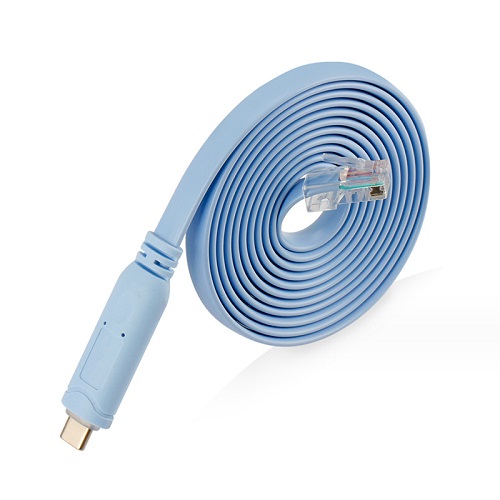 RJ45 is a kind of information socket (that is, communication outlet) connector in the wiring system, the connector is composed of a plug (connector, crystal head) and a socket (module), and the plug has 8 grooves and 8 contacts. RJ45 Plug, also known as RJ45 Modular Plug, is used to end data cables to realize the connection and change between equipment and distribution frame modules.
RJ45 is a kind of information socket (that is, communication outlet) connector in the wiring system, the connector is composed of a plug (connector, crystal head) and a socket (module), and the plug has 8 grooves and 8 contacts. RJ45 Plug, also known as RJ45 Modular Plug, is used to end data cables to realize the connection and change between equipment and distribution frame modules.
This USB3.1 to RJ45 Console debugging cable adopts British FTDI-FT232 chip to provide better stability and compatibility, and easily realize engineering level and high-performance communication between computer and RS232 equipment.
New generation of USB Type C to RJ45 for Cisco Router Console CableMakes connection from tables Type-C USB port directly to a console port without any concern.
Connects mobile phone,panel computer or Notebook PC(The port must be usb-c typetouch to the console port on Cisco networking gear.it is aso compatible with other brands of neworking equipmentthat use the same style of console port.
1. Connector:RJ45 and type -c
2.length:1.8M
3.Colour:LightSkyBlue
Packaging & Shipp | |
Packaging | PE bag per pcs Customized packaging is available |
Carton size | 40cm*30cm*25 cm. Customized carton is available |
Shipping by air | 2-7days |
Shipping by vessel | 10-25days depend on the port of destination |
Logistics and transportation | sea transportation/air transportation/land transportation |
Payment method | TT |
Minimum order quantity | 200pcs |
Delivery time | 15~25D |
Supply capacity/month | 50000PCS |
A console cable is a type of cable used to establish a direct connection between a computer and networking equipment, such as routers, switches, and other network devices. It is commonly used for configuration, monitoring, and troubleshooting purposes. The console cable facilitates a serial connection, allowing users to access the command-line interface (CLI) or console of the network device.
Key features of a console cable:
Connector Types: Console cables typically have one end with a standard serial connector (often a 9-pin or 25-pin serial connector) that connects to the computer's serial port or a USB-to-serial adapter. The other end of the cable connects to the console port on the networking equipment, which is usually an RJ45 connector.
RJ45 to Serial Adapter: Many modern networking devices use an RJ45 console port. In such cases, the console cable may include an RJ45 to serial adapter, allowing it to connect to the serial port of the computer.
Serial Communication: The console cable facilitates serial communication between the computer and the network device. This communication is typically done using RS-232 or USB-to-serial protocols.
Configuration and Monitoring: The console connection is often used for initial device configuration, monitoring, troubleshooting, and performing firmware or software updates. It provides direct access to the device's command-line interface (CLI) for configuration tasks.
Cross-Over Wiring: Console cables often use cross-over wiring, meaning that the transmit (TX) pin on one end connects to the receive (RX) pin on the other end. This configuration allows bidirectional communication between the computer and the network device.
Various Lengths: Console cables are available in various lengths to accommodate different networking setups. The length required depends on the distance between the computer and the network device.
USB Console Cables: In addition to traditional serial console cables, there are USB console cables that connect to a computer's USB port. These cables have a USB connector on one end and an RJ45 or other connector on the other end.
Console cables are essential tools for network administrators and IT professionals, providing a direct means of communication with network devices for management and troubleshooting purposes. When working with networking equipment, having a console cable on hand is often crucial for accessing and configuring devices.